It sometimes seems as though the affordable-housing sector—which is presumably watching every dollar to scrimp or scrounge—regularly achieves standards of energy performance and livability that much of the market-driven sector barely aspires to.
The square footage of Passive House–certified multifamily development, for example, has more than tripled in the last five years, with affordable housing accounting for over 90 percent of the sector, according to Phius, a Passive House training, advocacy, and certification nonprofit. Similarly, the number of affordable-housing projects registered with one of the certification programs administered by the International Living Future Institute (ILFI) has more than doubled in the same period, with even more projects piloting the Living Building Challenge Affordable Housing Framework. Nearly 80 percent of multifamily projects that certified as GreenPoint Rated between 2020 and 2024 are affordable, with a dramatic upswing in the percent achieving the Gold or Platinum level.
Under LEED, 438 affordable-housing developments, representing 6,521 units, achieved certification in 2023 alone.
What’s driving the sector’s sustainability and livability achievements, how do ambitious goals fit into tight budgets, and are there lessons for fostering more environmentally and socially responsible multifamily housing nationwide? record put these questions to Phius, ILFI, and the design teams behind three outstanding affordable-housing projects: Betances Residence, a Passive House–certified senior residence in the Bronx, New York, by COOKFOX Architects; Coliseum Place, a Living Building Challenge Affordable Housing Pilot and GreenPoint Rated Platinum building in Oakland by David Baker Architects (DBA); and 981 Davie Street, a Passive House–aspiring tower in Vancouver, British Columbia, by ZGF Architects.
The ambitions of all three projects, and similar achievements sector-wide, can be largely explained by three primary factors. The first is developers’ social mission: “It’s not only about housing—it’s about quality housing,” says Darin Reynolds, a partner with COOKFOX. And, even though housing is the core mission, adds Katie Ackerly, a principal and sustainable-design director at DBA, “that purpose often aligns with making the world a better place in multiple ways.” The health impacts of the built environment are especially significant in the affordable sector, “more so than for market-rate buildings,” says Susan Puri, affordable-housing director at ILFI, referring to data that correlate low-income communities with poor air quality and other environmental hazards, “because for a long time the built environment has perpetuated social inequities.”
The second factor is social policy, especially when it’s expressed through funding criteria and incentives. For example, federal low-income-housing tax-credit programs (LIHTC), which provide a significant portion of many affordable developments’ budgets, are distributed through competitive programs (known as qualified allocation plans, or QAPs) run by state housing-finance agencies. A growing number of QAPs award points for environmental responsibility. In fact, Phius largely attributes the surge in the sector’s uptake of Passive House to incentives in the QAPs of more than 17 states.
The third factor linking affordable housing and building performance is long-term ownership, which aligns both with social housing developers’ mission and with common funding requirements. LIHTC-funded projects, for example, are required to preserve their affordability for 30 years. With a long-term view, reduced operating costs can more than reimburse up-front premiums, if any, associated with developing a high-performance building (as long as funders’ caps on per-unit costs don’t get in the way).
These three factors—client mission, funding-backed policy, and long-term ownership—pushed the performance goals of each of the three example projects. The specifics of the achievements and the strategies for realizing them on limited budgets vary with the circumstances unique to each project.
Betances Residence, in the Bronx, New York, restores the urban streetwall at the front facade (above), but has a courtyard at the rear (top of page). Photo © Frank Oudeman, click to enlarge.
For Betances Residence, requirements to provide below-market housing for seniors, to certify under Enterprise Green Communities (a point-based environmental standard for affordable housing), and to achieve exemplary energy performance came as conditions of funding. Built on two formerly empty lots, one owned by the New York City Housing Authority and the other by New York City Housing Preservation and Development, the Passive House–certified Betances provides 152 units of supportive housing for at-risk seniors and achieves a 69 percent reduction in energy-use intensity (EUI) compared to a baseline building (17.4 kBtu/sf/yr versus 56). The eight-story structure, completed in 2022, was built for $560 per square foot and $440,000 per unit. The developer, Breaking Ground, says the budget is in line with comparable affordable multifamily projects where requirements for paying the local prevailing wage apply, and Reynolds says it’s significantly lower than a market-rate development.
To get the most bang for the buck, Betances is designed to maximize floor area within a tight zoning envelope. Much of the ground floor is recessed more than 50 percent below grade, a move that gains almost an entire story of usable space in addition to the zoning-allowed floor area. A central courtyard, also recessed, provides daylight and views that make the library, social services, and other common areas on this floor feel as though they’re at grade. Further boosting the buildable square footage, an economical block-and-plank structure, consisting of CMU bearing walls and precast concrete-plank floor slabs, makes a floor-to-floor height of 9 feet viable. This enabled more units to be constructed within the site’s height limit while still providing ceilings of 8 feet and higher for residents.
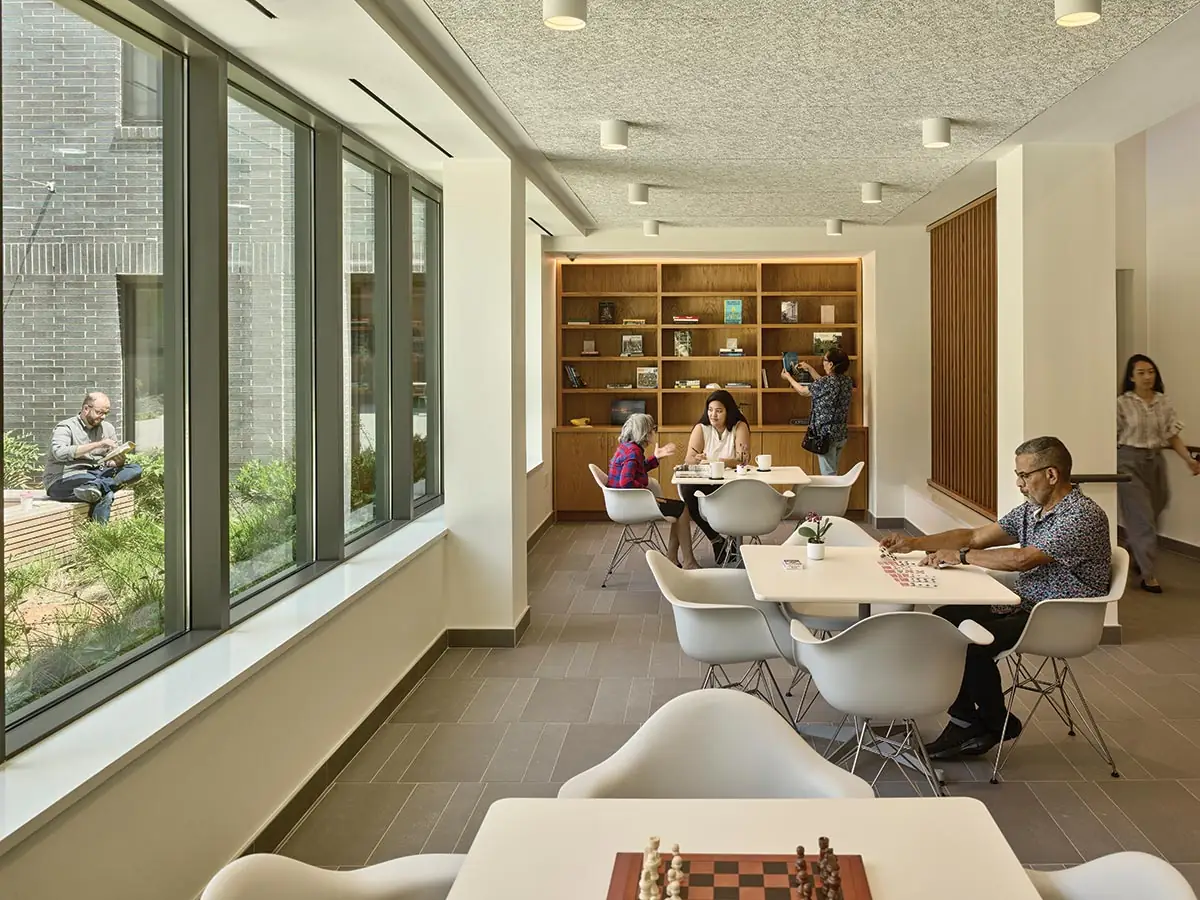
1
Social spaces at Betances look out onto the courtyard (1) as does the lobby (2), where light from a generous window calls attention to the texture of its corbelled brick wall. Photos © Frank Oudeman
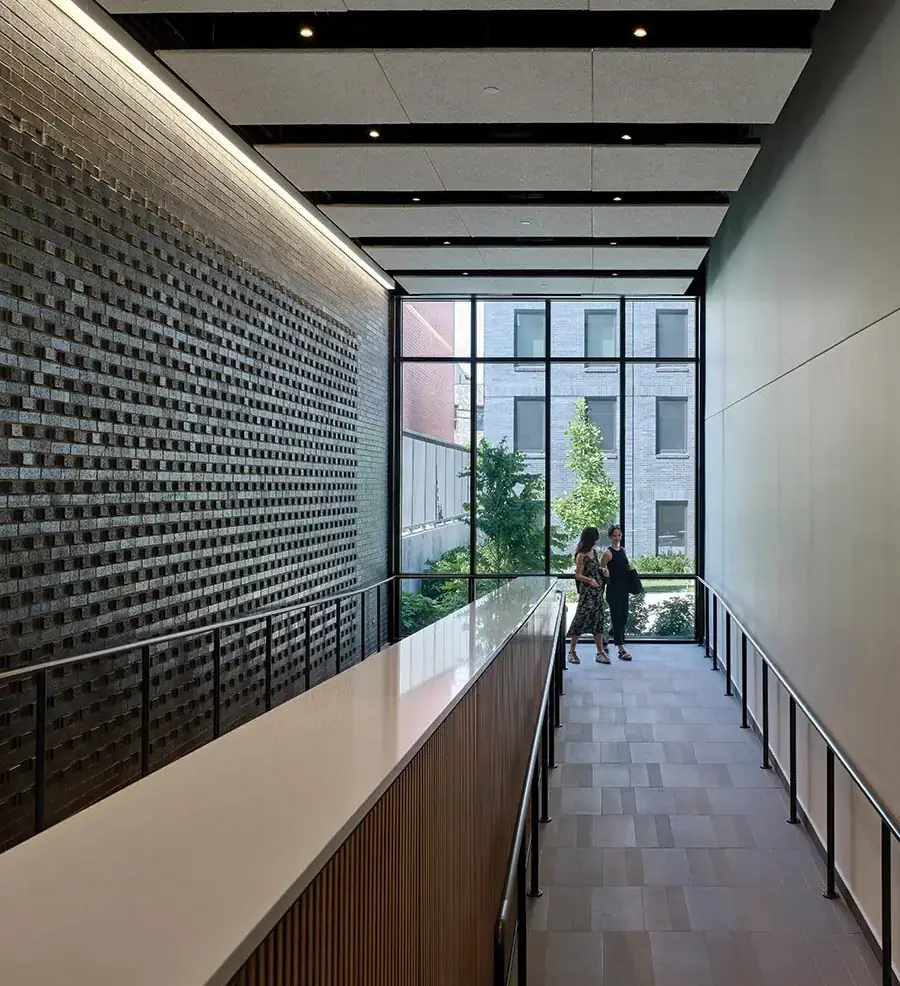
2
A high-performance envelope and energy-recovery ventilators provide benefits beyond energy savings. These include quality indoor air in a neighborhood with some of the worst asthma rates in the country and quiet interiors despite the proximity of highway traffic.
The building’s material palette was carefully selected to reinforce the project’s values. Cost-effective brick cladding conveys a sense of dignity and permanence that’s especially welcome in what may be residents’ first experience of housing stability in years. Brick also lines the walls of the lobby, where it is corbelled to create patterns and plays of shadow in the daylight from generous windows to the courtyard. The lobby brick doesn’t add significant cost, Reynolds says, “but it adds an incredible value for the people who are experiencing that space.” Other common-area materials, chosen for their evocation of nature, include wood slats along the lobby ramp and wood-fiber ceiling panels, a low-cost choice for softening the space’s acoustics. “We’re trying to achieve multiple things through simple choices,” Reynolds says. “For a client like Breaking Ground, which provides social services to their tenants, designing to support occupants’ health and well-being can help save money in the long run.”
As with Betances, the social and environmental performance of Coliseum Place, completed in 2022, resulted from a combination of funding- and mission-driven priorities. Located beside a commuter rail station, the six-story, 59-unit development for low-income and formerly unhoused families is adjacent to what’s intended to become a larger transit-oriented development. With the nonprofit developer Resources for Community Development seeking to surpass the LEED Platinum rating that had become its standard, the project enrolled in the ILFI Affordable Housing Pilot. Pilot projects attempt a range of ILFI certifications (including Living Building Challenge, Core, Zero Carbon, and Zero Energy), with access to educational sessions, peer-to-peer discussions, and support from the institute’s technical staff, all with the goal of breaking down barriers to deep-green housing. “We learned a ton about what’s appropriate for affordable housing in terms of these aspirational goals,” says DBA’s Ackerly—“what it takes to get there, and also what it means when a certification is driving your goal-set versus supporting a set of inherent goals and quality assurance.”
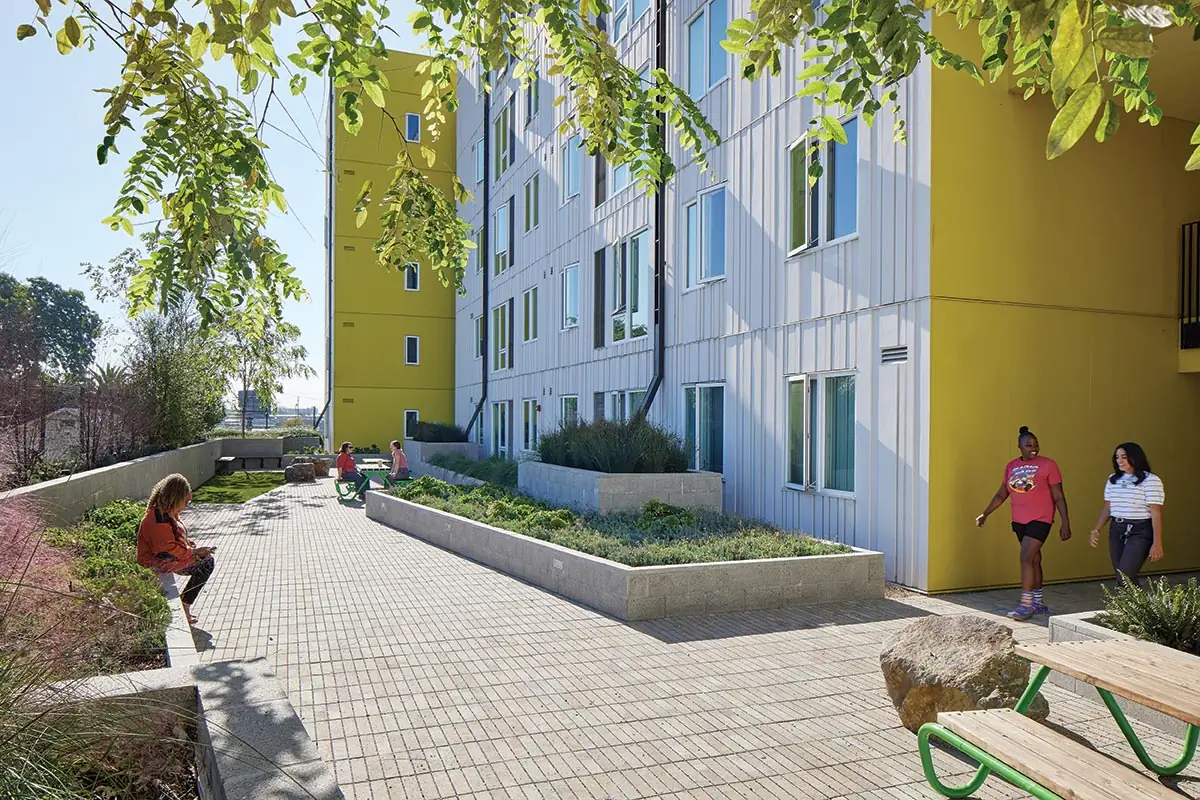
3
Coliseum Place in Oakland, California, has a landscaped podium (3) and is wrapped in a shade screen (4). Rooftop photovoltaics meet the energy needs of common areas, such as the lobby (5). Photos © Bruce Damonte
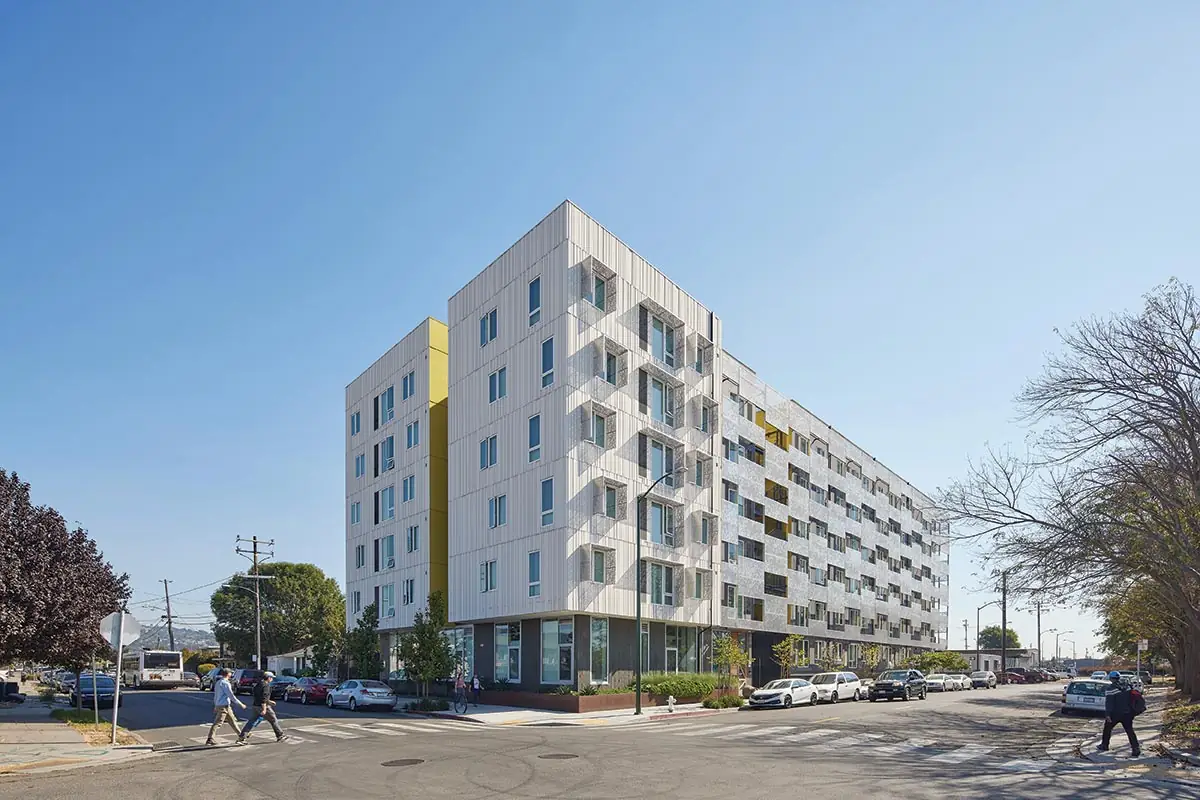
4
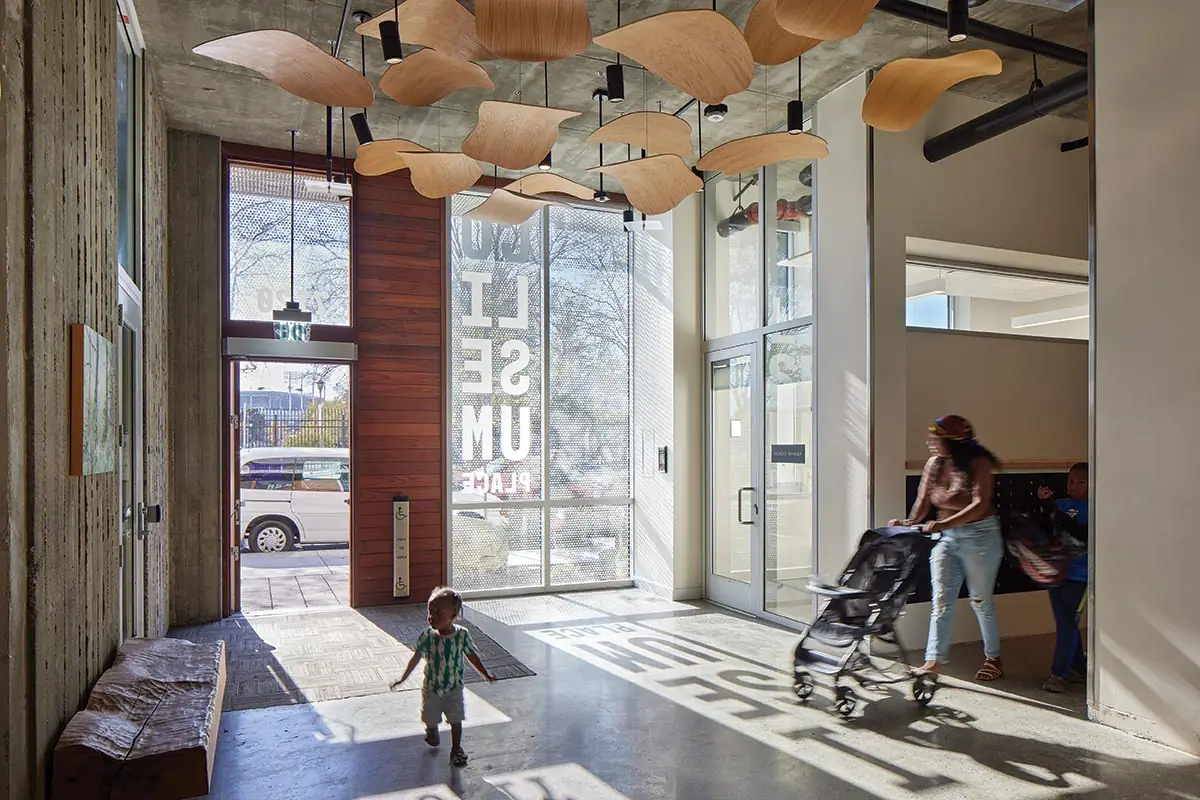
5
Built for construction costs of about $500,000 a unit—“which was pretty typical and pretty alarming at the time,” Ackerly says, “and now of course costs in this market are even higher”—Coliseum Place consists of a simple stepped massing wrapped in a shade screen. A bamboo-filled exterior staircase connects common amenities, fosters active uses and social interaction, and provides both a close-up with nature and expansive views to San Francisco and the East Bay Hills. Rooftop photovoltaics supply the annual energy needs of common areas in the all-electric building. Decentralized heat pumps reduce domestic hot-water energy loads by about 40 percent compared to a conventional central water heater. And air-conditioning and air filtration improve resilience in the face of increasingly hot and smoke-filled seasons.
In line with the pilot’s ambition of reducing negative health impacts, both for residents and for workers, DBA specified toxin- and plastic-free interior finishes; however, in what Ackerly calls “a value-engineering sob story,” a number of these were substituted out. Another aspect of the Living Building Challenge, the requirement that a building source all its water on-site and clean all the water it releases, was rejected from the outset. “There are good reasons that we have municipal-scale infrastructure,” Ackerly says. “In asking what to prioritize, you really have to start with, ‘What does this community need?’”
A grant-funded study that DBA conducted after the completion of Coliseum Place, however, suggests that there is a way in which affordable housing may be suited to doubling as infrastructure. The study’s challenge was to design a multifamily building that eliminated all energy demand from the grid between 4 and 9 p.m., typically the period of maximum energy draw, when power plants have to ramp up production fast—burning fossil fuels to do so—and when, as a result, energy is dirtiest. Reducing energy use during this period can have a greater impact on carbon emissions than reducing energy use overall. The exercise revealed that an oversize central hot-water tank could serve as a thermal battery, heating water during off-peak hours and supplying it during peak hours without drawing further from the grid. (This is different from Coliseum Place’s decentralized system, which focused on reducing total energy consumption.) The additional thermal storage uses a system that is already in the building—oversizing it even adds a level of redundancy that owners value—and could eliminate 35 percent of the building’s afternoon peak for less cost than battery storage (another way of storing energy in buildings to reduce peak loads). “It’s a really high-benefit, low-cost way to achieve this kind of evening-out-the-peak goal,” Ackerly says, “and that should be the focus of everything right now.”
Click plan to enlarge. Image courtesy of DBA
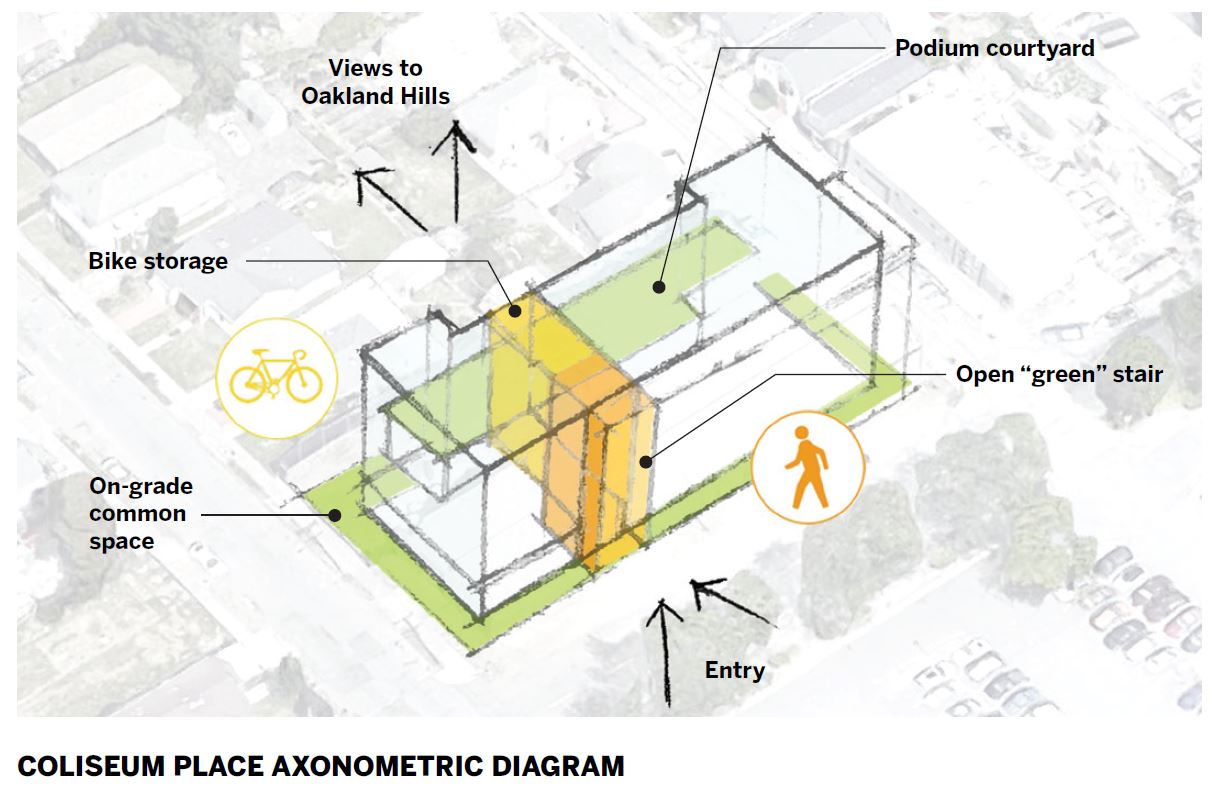
Another project reevaluating the systems best suited to achieving affordable and environmentally responsible housing is 981 Davie Street, a 17-story hybrid mass-timber tower now under construction and targeting Passive House certification. Projected to cost $67 million, with federal, provincial, and municipal funding, and developed by the Community Land Trust in consultation with New Commons Development, the building includes a mix of units, from studios to three-bedroom, with 6,800 square feet of amenities and outdoor space. Located in a neighborhood known for its thriving LGBTQ community, the building includes 154 affordable units, with 31 of them designated as supportive housing for individuals and families living with HIV/AIDS, and houses in its two-story podium a nonprofit community center that works to improve queer, transgender, and nonbinary people’s lives.
The City of Vancouver’s green buildings policy requires projects subject to rezoning to achieve exemplary energy performance by either of two paths: the penultimate level of the province of British Columbia’s Energy Step Code or Passive House certification. The 981 Davie team elected to target Passive House because the developer sees value in the quality assurance and reduced operations costs that achieving the standard represents, says ZGF project architect Daniel Wilson.
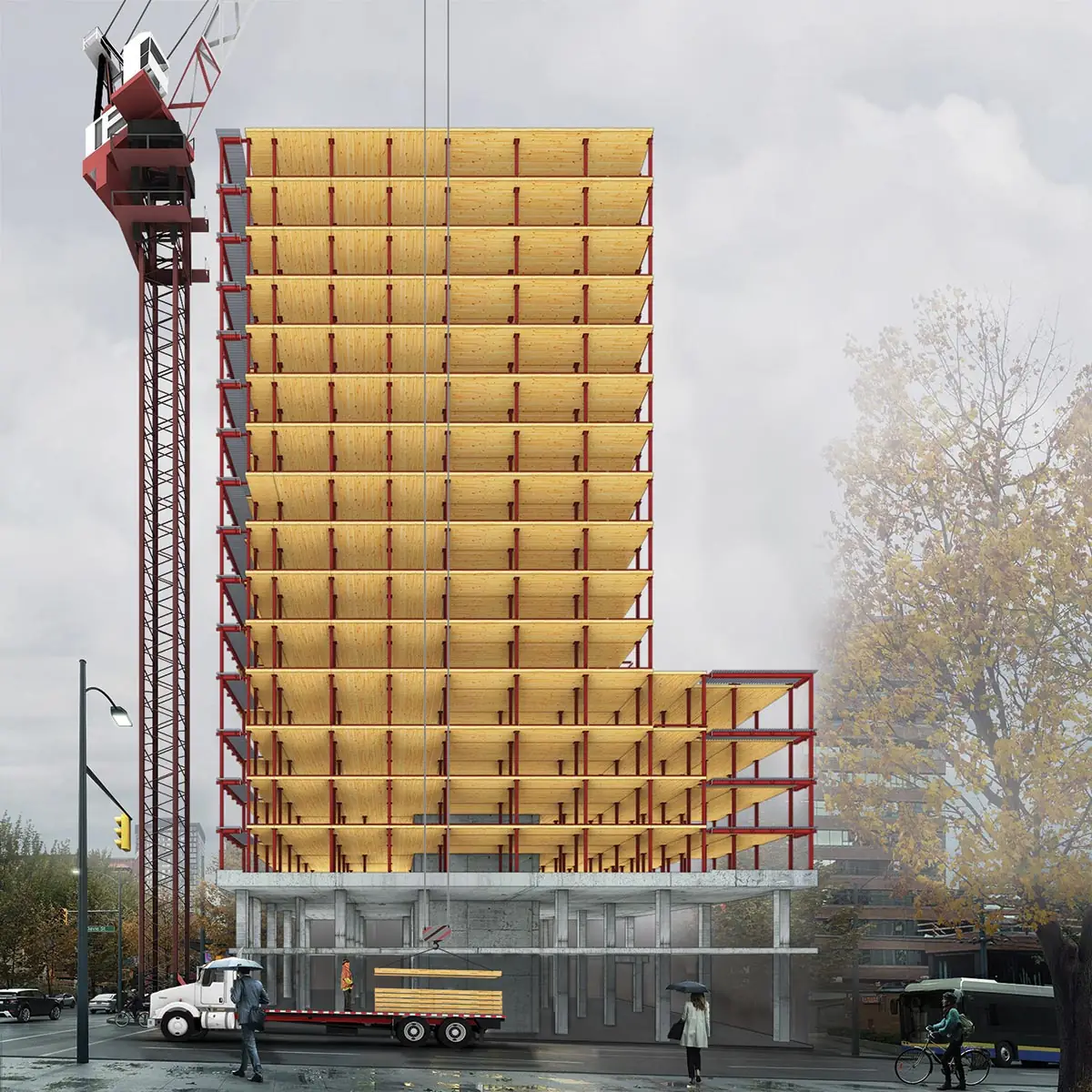
6
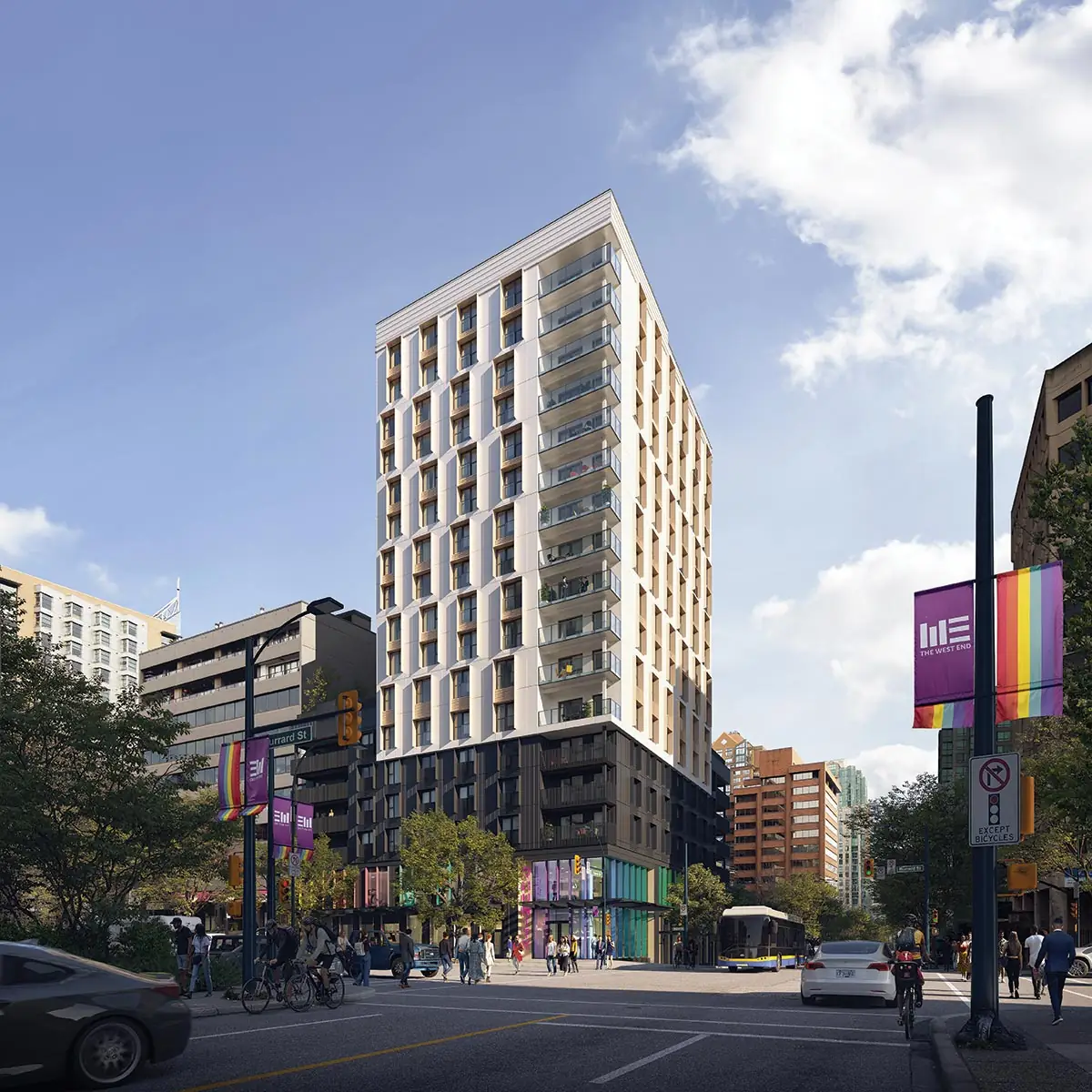
7
A structural system combining CLT slabs and steel columns (5) should speed construction at 981 Davie (6), in Vancouver, British Columbia. The building will provide 154 affordable units. Photos courtesy of ZGF
Because of the site’s densely developed urban context, which offered no staging room at all, the project uses prefabrication for both structure and envelope. The structure is pioneering a hybrid system, developed by its engineers, Fast and Epp, consisting of hollow-section steel (HSS) for the vertical members and cross-laminated timber (CLT) slabs for the horizontal. The HSS is cheaper and lighter, and the connection detail is faster and simpler than it would be with comparable-strength timber columns, and the flat slabs eliminate the need for beams and facilitate the installation of services. To keep pace with the structure’s speed of assembly while maintaining quality control and airtightness, the project uses a proprietary prefabricated envelope system, including operable triple-glazed windows and fixed shading devices. While there’s an associated cost premium, Wilson says, prefabrication offers the potential for robust and high-performing assemblies, as well as significant savings from a construction schedule slated to take a week and a half per level, including structure, envelope, and balconies.
The use of prefabricated systems also affected the project’s delivery method, since consultants, contractors, and manufacturers had to be brought on board earlier than would have been typical with tendering through a conventional design-bid-build process. Instead, the project is being delivered under a construction-management contract, with the general contractor preselected for advisory services during preconstruction and subsequently retained for construction. Portions of the project’s scope were pre-bid by relevant subcontractors in advance of a comprehensive tender. “The provincial funding authorities weren’t used to having to lock in certain players,” Wilson says, “so that was an educational process.” Ultimately, however, “as required for a publicly funded project, technically speaking all portions of the project were subject to competitive bidding between multiple prospective subcontractors.”
In addition to the housing it provides, 981 Davie serves a significant policy goal: modeling the viability of advanced building systems for broader market uptake. “This project forms part of the tradition of the federal and provincial governments providing funding in order to make experimental, cutting-edge projects possible that ordinarily would be dismissed as unviable by the market,” Wilson says. “If we want to create better living environments, the money for research has to come from somewhere. The argument here is that it doesn’t have to be somehow underpinned by market value—that it’s possible for the public sector to lead even market developments, and that it should do so.”
In allocating their careful budgets for maximum social and environmental effect, all three projects, Betances Residence, Coliseum Place, and 981 Davie—as well as the many other high-achieving affordable-housing projects now being built—share in that leading role, showing what’s possible.
Click plan to enlarge. Image courtesy of ZGF
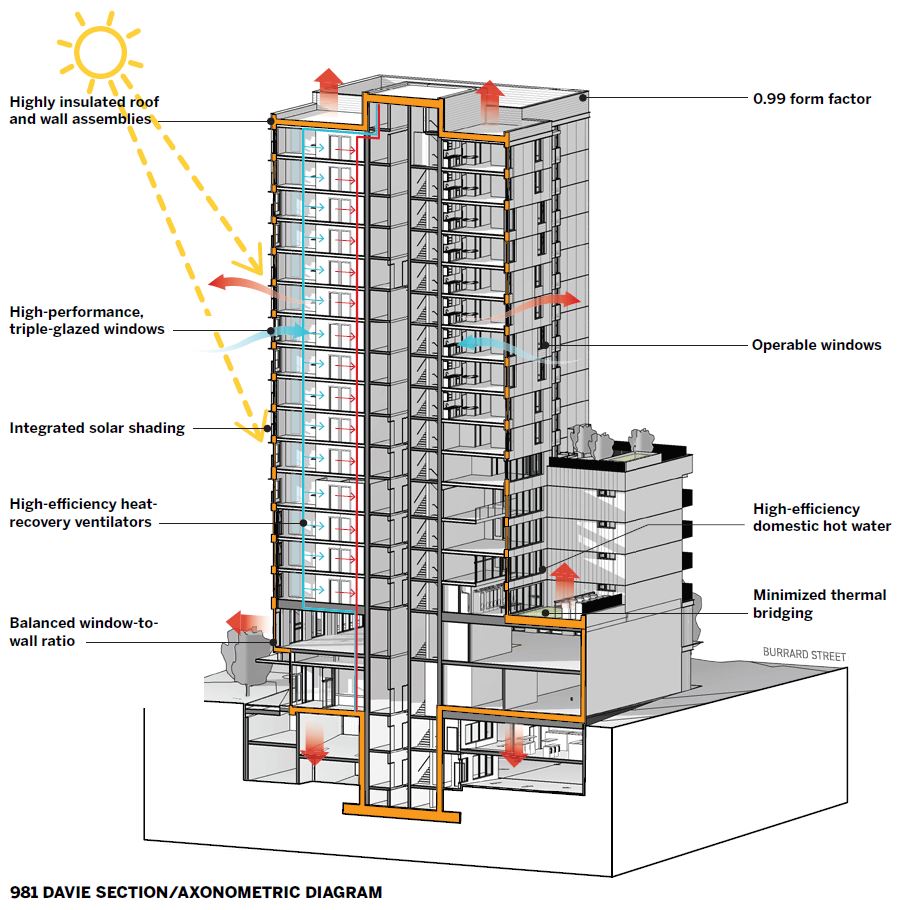
Continuing Education

To earn one AIA learning unit (LU), including one hour of health, safety, and welfare (HSW) credit, read the article above and Living Building Challenge: Framework for Affordable Housing, International Living Future Institute, Pages 21-24. Then complete the quiz.
Upon passing the quiz, you will receive a certificate of completion, and your credit will be automatically reported to the AIA. Additional information regarding credit-reporting and continuing-education requirements can be found at continuingeducation.bnpmedia.com.
Learning Objectives
- Explain how public policy and funding streams help affordable housing achieve high levels of energy performance.
- Discuss how materials choices can save money while supporting occupants’ health and well-being.
- Describe strategies for designing housing to reduce energy demand during peak hours.
- Outline the anticipated schedule and energyperformance advantages of the structural and envelope systems designed for 981 Davie.
AIA/CES Course #K2405A


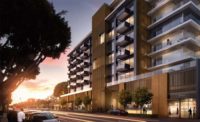
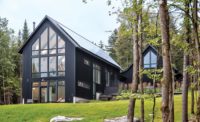

Post a comment to this article
Report Abusive Comment